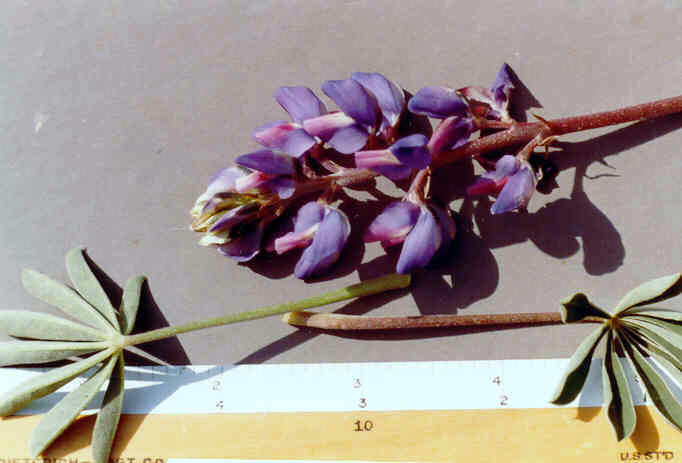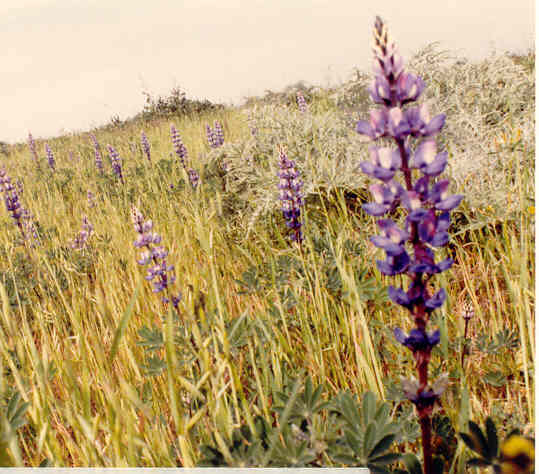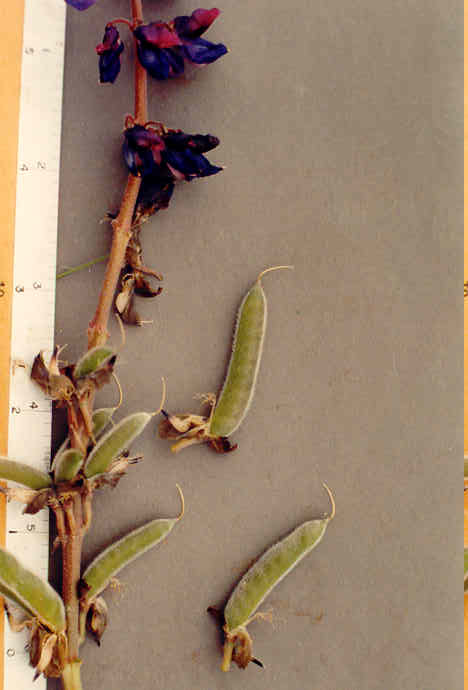
Lupinus succulentus Koch
 |
Lupinus succulentus Koch
Fabaceae (Pea Family)NativeCommon LupineArroyo LupineSucculent LupineDove Lupine |
February Photo
Plant Characteristics:
Annual, glabrate or sparsely pubescent, with hairs lying flat, stout,
usually succulent, branched, 2-8 dm. tall; lvs. long petioled, 6-12 cm.,
glabrous above, leaflets 7-9, rather dark green, leaves obovate; fls. in whorls
or groups, 6-30 cm. long; pedicels 4-6 mm. long, spreading-pubescent, deep blue
to almost white, banner with yellow center turning violet, wings slightly
ciliate at base, keel ciliate near claws, both above and below; pods about 5 cm.
long, loosely pubescent, several seeded, seeds oblong, marbled with a dark
brown, a pair of whitish spots embracing the micropyle.
Habitat:
Usually in heavy soil on grassy flats and slopes below 2000 ft.; many
Plant Communities; n. L. Calif. to n. Calif.
Feb-May.
Name:
Latin, lupus, a wolf, because
of an old idea that lupines rob the soil. Succulentus
means thick and fleshy, juicy. This
plant is thicker and fleshier than other Lupines.
(Dale 114). There are 48
species of lupine listed in Munz, Flora of
Southern California.
General:
The most common of the Lupines in the study area.
Photographed on the North Star Flats and Santa Ana Heights Bluffs.
(my comments). Many
lupines are poisonous to livestock. (Robbins
et al. 261).
No Cahuilla Indian of today can recall any practical uses for the various
species of lupine found in Cahuilla Territory
(generally the San Jacinto and San Bernardino Mountains and the Colorado
Desert). (Bean and Saubel 86).
Indians made a tea from the seeds of Lupinus
sp. and used it medicinally, especially to help urination.
Early in the spring, leaves and flowers were stripped off and steamed,
then eaten with acorn soup. Seeds
are often dangerous because of alkaloids. (Sweet
42). Some flowers have no nectar and offer only pollen to
attract potential pollinators. Lupinus, Eschscholzia, and Rosa
are examples of genera with nectarless flowers. Because they receive no
immediate energy from pollen, bumble bees must visit nectar-bearing plants while
foraging for pollen. When nectar-bearing flowers are widely spaced bumble bees
may borrow nectar from the nest before they leave for the pollen bearing
flowers; an advantage not enjoyed by non-social (solitary) bees. (Thorp, Robbin W.,
Schroeder, Peter C and Ferguson, Carol S. “Bumble Bees: Boisterous Pollinators
of Native California Flowers” FREMONTIA, A Journal of the California Native
Plant Society. Vol. 30, Nos 3-4 July-Oct. 2002 pp. 26-31).
Often seeded
on road banks. (Hickman, Ed. 636).
Text Ref:
Dale 114; Hickman, Ed. 636; Munz, Flora
So. Calif. 462; Roberts 24.
Photo Ref:
Feb. 1 83 # 35A; Mar 2 85 # 3; Mar 3 85 # 1.
Identity: by R. De Ruff,
confirmed by F. Roberts.
First Found: February 1983.
Computer Ref: Plant Data 77.
Have plant specimen.
Last edit 5/23/04 .
 |
 |
March Photo March Photo